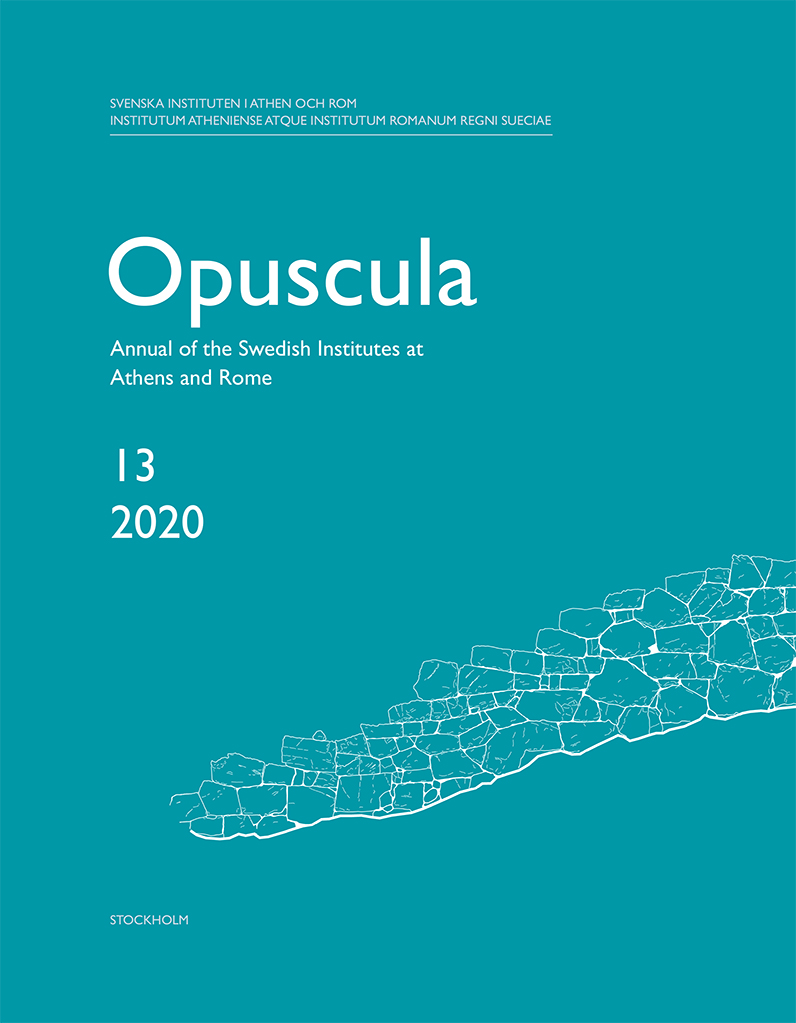Opuscula is published by the Swedish Institutes at Athens and Rome, with the aid of a grant from the Swedish Research Council. Distributed by Eddy.se AB. View journal at ERIH PLUS. All content available with open access. Memorial sculpture in the Protestant Cemetery at Rome. New discoveries and an inventory of identified works By Nicholas Stanley-Price Abstract The funerary sculpture in the Protestant Cemetery in Rome, the heart of Catholicism, has been little studied. A new inventory of monuments lists over 130 works for which the sculptor, architect or bronze foundry, either Italian or non-Italian, has been identified. Many new identifications, often based on previously unrecorded inscriptions, have brought to light the work of well-documented foreign sculptors who had settled in Rome either temporarily or permanently. Several elaborate monuments were evidently commissions from wealthy relatives or friends of the deceased, but a greater number were contributed by artistic family members or by other fellow artists. In these frequent cases, a desire to commemorate a relative or personal friend, rather than financial gain, would have been the primary motivation. Bibliographical information Nicholas Stanley-Price, ‘Memorial sculpture in the Protestant Cemetery at Rome. New discoveries and an inventory of identified works’, Opuscula. Annual…
Opuscula is published by the Swedish Institutes at Athens and Rome, with the aid of a grant from the Swedish Research Council. Distributed by Eddy.se AB. View journal at ERIH PLUS. All content available with open access. The Old Cemetery for Foreigners in Rome with a new Inventory of its burials By Nicholas Stanley-Price (Non-Catholic Cemetery for Foreigners, Rome, Italy) Abstract From at least 1716 until formal closure of the Cemetery in 1822, non-Catholic foreigners dying in Rome were usually buried adjacent to the Pyramid of Gaius Cestius in Testaccio. Some 80 stone monuments in the Old Cemetery were systematically recorded in the 1980s. To these can now be added a similar number of burials known from travel accounts and archival sources. This new, combined Inventory of 157 entries provides notes on the life and death in Rome for each individual. Its information modifies current perceptions that the Old Cemetery burials reflect mainly an élite, male population of Grand Tourists and aristocrats. Women are better represented, as are a wide range of professions, crafts, and domestic roles. A reassessment of the Cemetery’s layout leads to conclusions about its original extent, the first appearance of stone memorials in the 1760s, and…
Published by the Swedish Institute of Classical Studies in Rome. Distributed by Astrom Editions. Opuscula Romana 16 Contents Giovanni Colonna, ‘Il maestro dell’Ercole e delle Minerva. Nuova luce sull’attività dell’officina veiente’, pp. 7–41. Ingrid E.M. Edlund, ‘The sacred geography of southern Italy in Lycophron’s Alexandra’, pp. 43–49. Harry Erkell, ‘Varroniana III. Studi topografici. – Il culto all’Ara Maxima. Varro, De lingua latina V §§ 51–54 e VI § 54’, pp. 51–57. Erik J. Holmberg, ‘The Red-Line Painter’, pp. 59–90. Erik Nielsen, ‘Some preliminary thoughts on new and old terracottas’, pp. 91–119. Gad Rausing, ‘Charcoal, wheat and history’, pp. 121–124. Jocelyn Penny Small, ‘Left, right, and center: direction in Etruscan art’, pp. 125–135. Örjan Wikander, ‘Senators and equites. II. The aristocracy as agents of production’, pp. 137–145. Charlotte Wikander, Örjan Wikander & Giovanni Colonna, ‘An Etruscan inscription from Acquarossa’, pp. 147–148. Sebastian P.Q. Rahtz, ‘The Protestant Cemetery, Rome. A study undertaken under the auspices of the Unione Internazionale degli Instituti di Archeologia, Stora e Stora dell’arte in Roma. Interim report’, pp. 149–167. Carl Nylander, ‘The Swedish Institute in Rome (founded 1926). Report for the academic years 1984/85 and 1985/86’, pp. 169–171. ‘Guide for contributors to Opuscula Atheniensia and Opuscula Romana’, pp….



